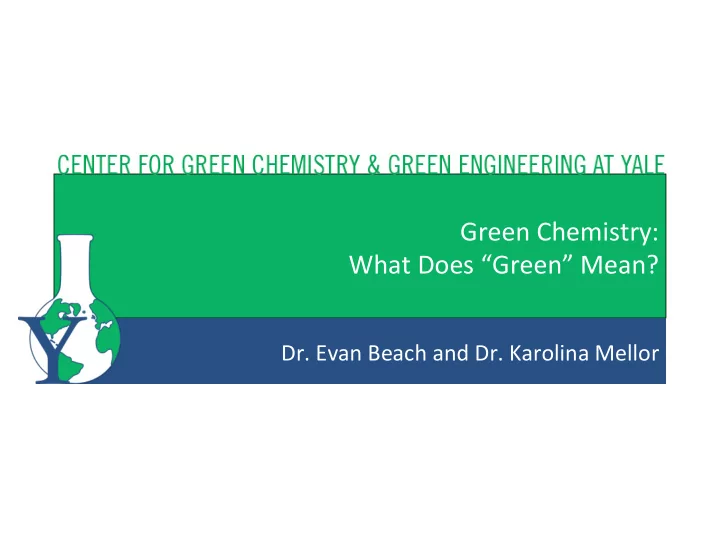

Green ¡Chemistry: ¡ ¡ What ¡Does ¡“Green” ¡Mean? ¡ Dr. ¡Evan ¡Beach ¡and ¡Dr. ¡Karolina ¡Mellor ¡
NSF/GCI/ANSI ¡355 ¡
What ¡green ¡chemistry ¡is ¡ not ¡ • Banning/restricGng ¡chemicals ¡ • Making ¡poliGcal/value ¡judgments ¡ • Dogma ¡
Green ¡Chemistry: ¡ Design ¡ Green ¡ chemistry ¡ is ¡ “the ¡ design ¡ of ¡ chemical ¡ products ¡ and ¡ processes ¡ that ¡ reduce ¡or ¡eliminate ¡the ¡use ¡and ¡genera4on ¡of ¡hazardous ¡substances” . ¡ ¡ ¡ Green ¡ chemistry ¡ recognizes ¡ hazard ¡ as ¡ a ¡ molecular ¡ property ¡ that ¡ chemists ¡ can ¡influence ¡in ¡the ¡same ¡way ¡that ¡we ¡design ¡molecules ¡for ¡color, ¡solubility, ¡ melGng ¡point, ¡reacGvity, ¡etc. ¡ ¡ Hazard ¡refers ¡to ¡the ¡endangerment ¡of ¡humans ¡or ¡other ¡life ¡we ¡depend ¡on: ¡ ¡ • Physical ¡danger— ¡fire ¡and ¡explosions ¡ • Global ¡deterioraGon ¡— ¡ ¡global ¡warming, ¡ozone ¡depleGon, ¡exhausGon ¡of ¡ natural ¡resources, ¡acid ¡rain, ¡and ¡others ¡ • Toxicological ¡effects— ¡acute ¡and ¡chronic, ¡including ¡emerging ¡issues ¡such ¡ as ¡endocrine ¡disrupGon ¡and ¡epigeneGc ¡phenomena ¡
What ¡green ¡chemistry ¡ is ¡ • Adding ¡a ¡layer ¡of ¡technical ¡challenge ¡ • Providing ¡new ¡tools ¡ • Providing ¡new ¡choices ¡ • A ¡process ¡of ¡conGnuous ¡improvement ¡
Principles ¡of ¡green ¡chemistry ¡(1998) ¡ 1. ¡It ¡is ¡be^er ¡to ¡prevent ¡waste ¡that ¡to ¡treat ¡or ¡clean ¡up ¡waste ¡a_er ¡it ¡is ¡formed. ¡ 2. ¡SyntheGc ¡methods ¡should ¡be ¡designed ¡to ¡maximize ¡the ¡incorporaGon ¡of ¡all ¡materials ¡used ¡ in ¡the ¡process ¡into ¡the ¡final ¡product. ¡ 3. ¡Wherever ¡pracGcable, ¡syntheGc ¡methodologies ¡should ¡be ¡designed ¡to ¡use ¡and ¡generate ¡ ¡ ¡ substances ¡that ¡possess ¡li^le ¡or ¡no ¡toxicity ¡to ¡human ¡health ¡and ¡the ¡environment. ¡ 4. ¡ Chemical ¡ products ¡ should ¡ be ¡ designed ¡ to ¡ preserve ¡ efficacy ¡ of ¡ funcGon ¡ while ¡ reducing ¡ toxicity. ¡ 5. ¡ The ¡ use ¡ of ¡ auxiliary ¡ substances ¡ (e.g. ¡ solvents, ¡ separaGon ¡ agents, ¡ etc.) ¡ Should ¡ be ¡ made ¡ unnecessary ¡ ¡wherever ¡possible ¡and, ¡innocuous ¡when ¡used. ¡ 6. ¡Energy ¡requirements ¡should ¡be ¡recognized ¡for ¡their ¡environmental ¡and ¡economic ¡impacts ¡ and ¡should ¡be ¡minimized. ¡SyntheGc ¡methods ¡should ¡be ¡conducted ¡at ¡ambient ¡temperature ¡ and ¡pressure. ¡ 7. ¡ A ¡ raw ¡ material ¡ or ¡ feedstock ¡ should ¡ be ¡ renewable ¡ rather ¡ than ¡ depleGng ¡ wherever ¡ technically ¡and ¡economically ¡pracGcable. ¡ 8. ¡Reduce ¡derivaGves ¡-‑ ¡Unnecessary ¡derivaGzaGon ¡(blocking ¡group, ¡protecGon/ ¡deprotecGon, ¡ temporary ¡modificaGon) ¡should ¡be ¡avoided ¡whenever ¡possible. ¡ 9. ¡CatalyGc ¡reagents ¡(as ¡selecGve ¡as ¡possible) ¡are ¡superior ¡to ¡stoichiometric ¡reagents. ¡ 10. ¡ Chemical ¡ products ¡ should ¡ be ¡ designed ¡ so ¡ that ¡ at ¡ the ¡ end ¡ of ¡ their ¡ funcGon ¡ they ¡ do ¡ not ¡ persist ¡in ¡the ¡environment ¡and ¡break ¡down ¡into ¡innocuous ¡degradaGon ¡products. ¡ 11. ¡AnalyGcal ¡methodologies ¡need ¡to ¡be ¡further ¡developed ¡to ¡allow ¡for ¡real-‑Gme, ¡in-‑process ¡ monitoring ¡and ¡control ¡prior ¡to ¡the ¡formaGon ¡of ¡hazardous ¡substances. ¡ 12. ¡Substances ¡and ¡the ¡form ¡of ¡a ¡substance ¡used ¡in ¡a ¡chemical ¡process ¡should ¡be ¡chosen ¡to ¡ minimize ¡potenGal ¡for ¡chemical ¡accidents, ¡including ¡releases, ¡explosions, ¡and ¡fires. ¡
12 ¡Principles ¡/ ¡Chemical ¡Life ¡Cycle ¡ • Across ¡the ¡lifecycle: ¡prevent ¡waste, ¡ minimize ¡energy ¡and ¡toxicity ¡impacts ¡
12 ¡Principles ¡/ ¡Chemical ¡Life ¡Cycle ¡ • Renewable ¡resources ¡
12 ¡Principles ¡/ ¡Chemical ¡Life ¡Cycle ¡ • EliminaGng ¡waste ¡via ¡atom ¡economy, ¡ selecGve ¡catalysts ¡ • AlternaGve ¡solvents ¡(water, ¡CO 2 , ¡etc.) ¡
12 ¡Principles ¡/ ¡Chemical ¡Life ¡Cycle ¡ • If ¡the ¡product ¡itself ¡presents ¡toxicological ¡ hazards? ¡ • “IntenGonal ¡use” ¡/ ¡unintended ¡consequences ¡
Life ¡Cycle ¡and ¡Toxicological ¡Hazards ¡ • Design ¡for ¡biodegradaGon, ¡idenGfy ¡ metabolites ¡
Green ¡chemistry: ¡addiGonal ¡resources ¡ Green ¡Chemistry . ¡ ¡ Journal ¡of ¡Chemical ¡Educa6on ¡ Published ¡by ¡the ¡ has ¡been ¡soliciGng ¡submissions ¡ Royal ¡Society ¡of ¡ related ¡specifically ¡to ¡green ¡ Chemistry ¡since ¡ chemistry ¡for ¡more ¡than ¡a ¡ 1999. ¡ decade. ¡ ChemSusChem . ¡ ¡ Green ¡Chemistry ¡Le:ers ¡& ¡ Published ¡by ¡Wiley ¡ Reviews. ¡ ¡ Published ¡by ¡Taylor ¡& ¡ since ¡2008. ¡ Francis ¡since ¡2008. ¡ Coming ¡soon: ¡ ACS ¡Sustainable ¡Chemistry ¡& ¡Engineering ; ¡ Current ¡Green ¡Chemistry ¡ (Bentham) ¡
PresidenGal ¡Green ¡Chemistry ¡Challenge ¡Awards ¡ • Small ¡Business ¡ • Academic ¡ • Industry ¡/ ¡greener ¡syntheGc ¡pathways ¡ • Industry ¡/ ¡greener ¡reacGon ¡condiGons ¡ • Industry ¡/ ¡design ¡of ¡greener ¡chemicals ¡
Safer ¡alternaGves ¡through ¡innovaGon ¡ U. ¡of ¡York ¡ U. ¡of ¡Leicester ¡ UMass-‑Lowell ¡ (M.Sc.) ¡ (M.Sc., ¡Ph.D.) ¡ (Ph.D.) ¡ U. ¡of ¡Zaragoza ¡ (M.Sc.) ¡ Sichuan ¡U. ¡ (M.Sc., ¡Ph.D.) ¡ U. ¡of ¡Western ¡Australia ¡ (B.Sc.) ¡ h^p://greenchem.uoregon.edu/Pages/MapDisplay.php ¡ ¡
Take-‑home ¡messages ¡ • “Green” ¡means ¡new ¡chemicals, ¡materials, ¡transformaGons, ¡ methodologies, ¡solvents, ¡molecules, ¡analyses, ¡and ¡tools ¡ • “Green” ¡means ¡design ¡and ¡conGnuous ¡improvement ¡at ¡the ¡ molecular ¡level ¡ • Green ¡chemistry ¡aims ¡to ¡fully ¡integrate ¡with ¡“regular” ¡chemistry, ¡ bringing ¡in ¡elements ¡of ¡engineering, ¡physics, ¡biology, ¡and ¡ toxicology. ¡ ¡
Recommend
More recommend